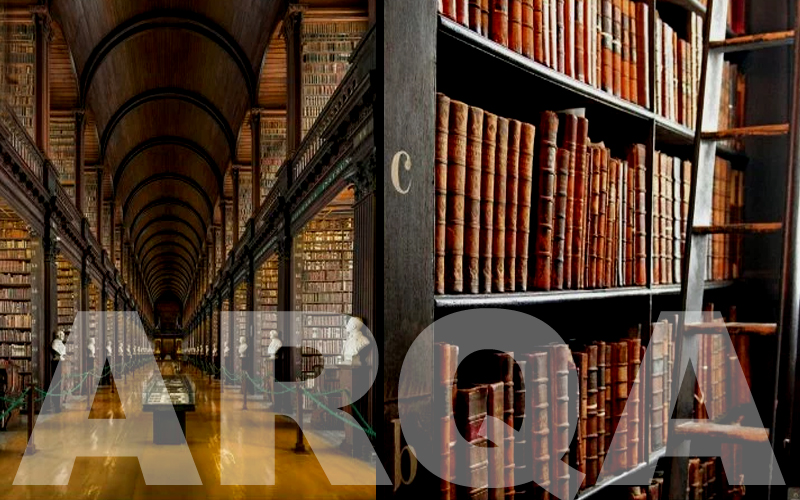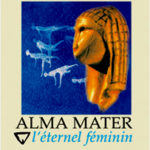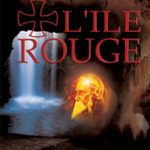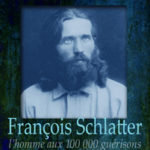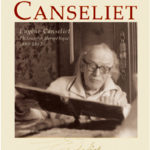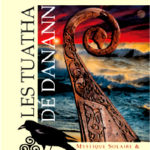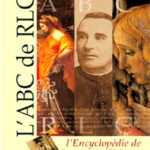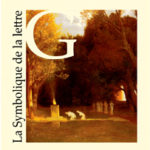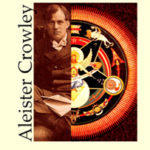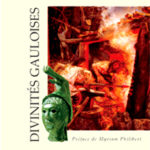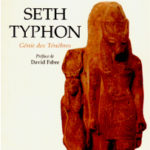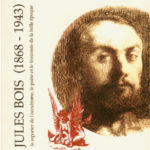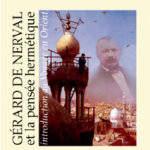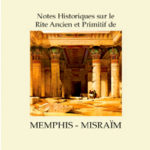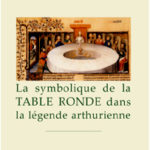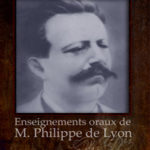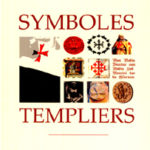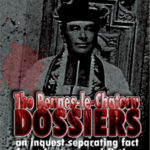
« Metaphysical traditions with a French accent »
Founded in France in 1999 by Thierry E. Garnier, Arqa Editions is a publishing company specializing in the domains of alternative history, Tradition, Hermeticism. Arqa offers rare and unusual volumes, works of erudite research, written by renown authors, enhanced with archival documents, enriched with an abundance of unpublished iconographic and photographic treasures, and supported by high-quality critical apparatus, while always adhering to high standards in production values.
Among ARQA Editions, you will find books on Gnosis, Templars, and Rose-Croix ; biographies of Monsieur Philippe de Lyon, Eugène Canseliet, Jules Bois, Francis Schlatter, Gerard de Nerval, Aleister Crowley. … ; works on operative Alchemy, books on Masonic initiation, Martinism, but also on Christian mysticism and Celtic spirituality… Works on Rennes-le-Chateau as well as on the ancient mysteries of France.
In 2014, ARQA Editions anticipates its introduction to the anglophone world, by presenting a foreign-rights catalog offering a selection of titles that may interest English-speaking readers.
Do you wish to know more? Do not hesitate to contact our US agent, Deborah Belle Forman, who will be pleased to inform you about the latest publications of ARQA Editions that are available for translation, as well as image banks on the Tradition…
ARQA editions
– contact Deborah Belle Forman

Francis Schlatter: The Man of a Hundred-Thousand Healings – Gil Alonso-Mier
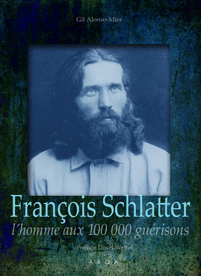 His destiny, his life, and his death remain a mystery. Gil Alonso-Mier
His destiny, his life, and his death remain a mystery. Gil Alonso-Mier
What an extraordinary destiny, in the full meaning of the word, was that of Francis Schlatter, this “Envoy from the Father.” Without doubt one of the greatest healers ever, today forgotten by history, but who is admirably restored to us in this memorable work of Gil Alonso-Mier, the first biography in the French language consecrated to this authentic miracle worker of 100,000 healings. Francis Schlatter was born April 29, 1856 at Ebersheim in Alsace, ninth child of a very pious family. Deaf and blind from birth, he will be healed from these afflictions as a young child, though exactly how, nobody really knows…by miracle in response to the prayers of his mother, it is said.
His exceptional destiny as one chosen for a unique mission, thus began, and continued without ever flagging. In 1870, at the death of his father, Francis decided on the humble profession of shoemaker, a profession also associated with the great theosophist Jacob Boehme…. Pointless to weigh in here on the symbolic dimension of the word (cordellier in French) and the function… But his path is laid out, it can be sensed and discerned.
Guided only by one whom he calls “Father,” he arrives as an immigrant in America in 1884 and settles in Denver where he opens his ministry as a healer, completely assured of his mission. Then, moved by an irresistible call, though virtually penniless, as he consistently refuses remuneration for his healing work, he undertakes a journey of 730 days on foot, through eight American states, a journey punctuated by multiple miraculous healings. Arrested for vagrancy, he was briefly imprisoned, but nothing and nobody could stop Francis who, continuing along his path arrived in Albuquerque, after a loop of about 5,500 miles, and decides to embark on a fast of forty days in the desert. Upon completing this highly symbolic purification, he returns to Denver, his point of departure, and installs himself there for long and intense daily healing sessions on a tightly packed and constantly increasing crowd who approach him to be healed and pay homage in gratitude for his extraordinary powers, given without recompense. Ultimately, there will be nearly 100,000 people suffering from all kinds of conditions, who will be healed by Francis Schlatter in the space of only fifty-eight days! On November 14, 1895, Mr. Fox, at whose home Schlatter resided while in Denver, finds a note in his chamber: “Mr. Fox, my mission is finished and the Father calls me. I salute you. Francis Schlatter.” Never again will this humble healer be seen, the one called by various names: “the greatest miracle worker of the century,” “the Healer,” “El Sanador,” “The walker with God,” “the Saint of Denver,” “the Prophet of 100,000 healings,” “the poor shoemaker of Colorado.” So … who was therefore Francis Schlatter, whom Papus— himself having been to a good school under Phillipe de Lyon—said in the review Initiation of March 1896: “Francis Schlatter was illuminated, and we will say for those who are in the know, that this man, of obscure birth and social position, was nevertheless one of the Eleven who passed through the door of the sun in 1855.” –In this multiple-facetted work, of a faultless erudition, after more than three long years of eminent research in France and in the United States, and thanks to a great many unpublished documents, published for the first time in this edition, Gil Alonso-Mier recounts to us in an unvarnished and sober style the astonishing life of Francis Schlatter.
Table of Contents
Part 1: The Life of the Harp in the Hand of the Harper by Francis Schlatter
Part 2: Biography of Francis Schlatter—From Childhood to the Call—The Pilgrimage of 730 Days—The Fast of Forty Days at Albuquerque—The Public Ministry at Denver—First Disappearance—Teachings on Retreat—Second Disappearance
Part 3 : The Gospel of Schlatter
Templar Symbols – Thierry E. Garnier
History is much too serious an occurrence to leave only to professional historians, whose capacities for imagination, invention and even reconstruction sometimes appear rather limited or even suspect.
Raymond Oursel (1921- 2008) – Historian of the Order of the Temple,
Author of the Procès des Templiers.
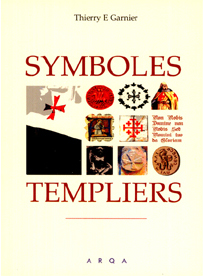 In this work, running counter to received ideas, one will not find the nineteenth- century version of the Templar armorial, an inauthenticated Templar devise, nor the Abacus of the “Grand Master,” the actual existence of which no one has ever verified. The history of the Templar Order is often recounted in a hurried way by historians hardly scrupulous with the sources they evoke – failing to supply archival references and copying references from text to text. What to say then about discussions of so-called “Templar symbols,” of which a part are dreamed up, a trap for the unwary, shamelessly accommodated to imaginary narratives, to Templar legends, to presupposed myths and histories of Templar treasures.
In this work, running counter to received ideas, one will not find the nineteenth- century version of the Templar armorial, an inauthenticated Templar devise, nor the Abacus of the “Grand Master,” the actual existence of which no one has ever verified. The history of the Templar Order is often recounted in a hurried way by historians hardly scrupulous with the sources they evoke – failing to supply archival references and copying references from text to text. What to say then about discussions of so-called “Templar symbols,” of which a part are dreamed up, a trap for the unwary, shamelessly accommodated to imaginary narratives, to Templar legends, to presupposed myths and histories of Templar treasures.
In this book, supported by verifiable historic facts, archives of calligraphed manuscripts, but also by a comprensive review of all the plastic arts, mobilized between the XIIth and XIVth centuries, including illuminated manuscripts, architecture and sculpture, stained-glass windows, frescos, stone engravings (bas reliefs and tombstones), seals, coins, and graffiti, the author determines a typological symbolique (symbolic language) belonging to the Militia of God, which may prove the best manner today of encountering the white-mantled knights. This work of Thierry E. Garnier, consecrated to the symbols of the Templars is the first work presenting an exhaustive vision of this highly controversial subject, a semantic field which also touches in part on what Medievalists have called “the Heresy of the Temple.”
Soul of the Mother- The Eternal Feminine – Myriam Philibert
 Alma Mater! The nourishing mother… Mother Earth and Mother Goddess. She has carried and cherished us since the dawn of Humanity. But what was her first representation—her different depictions, her symbolism among the Indo-Europeans and beyond? To discover this we must follow Miriam Philibert, step by step, on the trail of the Goddess, who, since the age of iron and flint to the wood-carved Black Virgins of the Middle Ages, allows us to walk along the trail with her, according to the myths, legends, and pathways of the earth, to the discovery of these tutelary deities, guardians for all eternity of the mysteries of the Origin. Who are they really, these prehistoric Venuses of the heavy breasts and stomachs? Gaia, the Celestial Great Mother, Cybele, Isis, or Lilith or Innana… The quest of the Eternal Feminine, quest for meaning, for the absolute and for knowledge, is it not the secret, the only authentic way of excellence, which permits us to rediscover the universal role of the Goddess, according to us, yes to all of us, men and women alike, to understand sincerely the interior thought of the sacred feminine, which inhabits us, to finally, peacefully unite our differences? Much more than one part dream, one part truth, without which we could not claim to rediscover the pathway of the stars… that of the Eternal Return.
Alma Mater! The nourishing mother… Mother Earth and Mother Goddess. She has carried and cherished us since the dawn of Humanity. But what was her first representation—her different depictions, her symbolism among the Indo-Europeans and beyond? To discover this we must follow Miriam Philibert, step by step, on the trail of the Goddess, who, since the age of iron and flint to the wood-carved Black Virgins of the Middle Ages, allows us to walk along the trail with her, according to the myths, legends, and pathways of the earth, to the discovery of these tutelary deities, guardians for all eternity of the mysteries of the Origin. Who are they really, these prehistoric Venuses of the heavy breasts and stomachs? Gaia, the Celestial Great Mother, Cybele, Isis, or Lilith or Innana… The quest of the Eternal Feminine, quest for meaning, for the absolute and for knowledge, is it not the secret, the only authentic way of excellence, which permits us to rediscover the universal role of the Goddess, according to us, yes to all of us, men and women alike, to understand sincerely the interior thought of the sacred feminine, which inhabits us, to finally, peacefully unite our differences? Much more than one part dream, one part truth, without which we could not claim to rediscover the pathway of the stars… that of the Eternal Return.
The 25th book of Myriam Philibert with 50 illustrations in the text.
Table of Contents
1. The Beginning: Unity—the Monad—the Duality—the Dyad, the Ternary—the Triad, from feminine principle to the archetype of the virgin mother,
2. The Earth and the Mother: the elements, the duality of the goddess, the ages of life, maternity, the the nourishing mother, death, the Great Mothers of antiquity, the question of the Mother Goddess
3. Celestial: The Cosmic Virgin: Heaven and Night, The Milky Way and the Aurora Borealis, the nail of heaven, the Moon, the Earth, planet and mother, the Sun Goddess, Venus and the other planets
4. Protectress or Monster: The Mother Animal—Maternal or monstrous? The goddess and the serpent, the goddess and the bird, the mother animal, the sacred cow, the woman, essence of maternity and of femininity
5. Exuberant, Vegetable Power: the forest primordial, the tree of life or of Knowledge, the mother of the barley, nature, the enchanted garden, Nymphs, Fairies, Blodduwed
6. Occult: the Mineral Matix: Cave, womb and/or Mother Earth, the Omphalos, the Mother Mountain, the magma and the mud, the water of life, the primordial waters and/or the sea, the flood as regenerator, the prima materia
7. The Eternal Feminine: Feminity, the spouse or the courtesan, the mother of the hearth, Woman as Object or goddess, male-female relationships, the eternal feminine, the Mysteries, Wisdom or feminine spirituality—the Return of the Goddess
242 pages – ISBN 2755100176
“Demeter! Mother Earth! A fruit?… Is it looking to be born on the Tree of Life? (Teilhard de Chardin)
In a few words, Father Teilhard de Chardin plants the tableau of the birth of the world such as ancient men would have conceived of it. A mother, earth and and clod of land productive both of life and of harvests, planet and universe entirely apart. For one does not really know by what miracle, a fruit arrives in life, or a son, or a sun. No one knows. Is it issued from her womb? No, it is attached to the tree of life. On one side, a mother with a huge belly, ample and generous. On the other, a child—a grain, then a man or a tree, straight and firm, links between the mother and the cosmos. Thus, the Goddess pre-exists all! Without her infinite potential of matter of form, of life, there would be no universe. This assertion appears among the most incongruous in a context entirely founded along interminable patriarchal lines. The Spirit seems to lose all power, unless some attracting femininity lends it to him. In calling her Demeter, Mother Goddess, the Greeks made of her a divine mother but in reality they placed her already on the second tier, as spouse or concubine of Zeus, and ruling over agriculture and its production. In their pantheon where the patriarchate had placed the latter beneath everything, what hope still existed for femininity and maternity? Gaia pre-existed everything, exuberant, indefatigable, prolific; Night determines the destiny of the world (and dictated his conduct to Zeus himself); Demeter watched over the harvest, assisted by a daughter whom Hades had ultimately ravished. This beautiful fable, which puts into operation a new ternary, divine and totally agrarian, Kore, Hecate, and Persephone, masks in fact an historical phenomenon—the intrusion of the Greeks into the country to which they had given their name. Before, and throughout time immemorial, an anonymous goddess had reigned. She was honored as the universal mother of the immortals as well as of the mortals. At the time of the glory of the Mycenians, the same goddess still had no name. Was she perhaps the spouse of the three gods who shared the world? Finally, she took the patronym of
Dê-mêter. The meaning of it is simple, of large reception, near to the original undifferentiated. Was it not suitable for a virgin mother to reproduce by parthenogenesis, as (…).
The Mystical Rose of the Fideli d’Amore – Gil Alonso-Mier
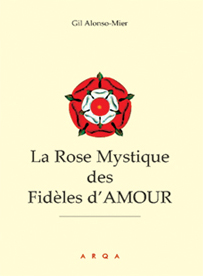 On the mythical theme of the Rose, the author Gil Alonso-Mier brings together here for the first time a collection of citations, aphorisms and extracts from texts of incomparable beauty and of exceptional purity. From the greatest Sufi Initiates to the Rose+Croix of the 18th century, Adeptes, Alchemists, Masters of Wisdom are all found in this enchanting book where the Mystic Rose of the Fideli d’Amore grows in the shade, embalmed with captivating perfumes of the Eternal Orient and with the Letters of Nobility, those of the ancient Perennial Tradition. This book, like a bouquet of roses placed by the author at the foot of the Cross on the altar of Consciousness, in homage to the cave of the Ancients and for the Passed Masters, will ravish all the knights in quest of the power incarnated in the breast of the Flower of flowers…
On the mythical theme of the Rose, the author Gil Alonso-Mier brings together here for the first time a collection of citations, aphorisms and extracts from texts of incomparable beauty and of exceptional purity. From the greatest Sufi Initiates to the Rose+Croix of the 18th century, Adeptes, Alchemists, Masters of Wisdom are all found in this enchanting book where the Mystic Rose of the Fideli d’Amore grows in the shade, embalmed with captivating perfumes of the Eternal Orient and with the Letters of Nobility, those of the ancient Perennial Tradition. This book, like a bouquet of roses placed by the author at the foot of the Cross on the altar of Consciousness, in homage to the cave of the Ancients and for the Passed Masters, will ravish all the knights in quest of the power incarnated in the breast of the Flower of flowers…
Table of Contents/Introduction by Gil Alonso-Mier-Collection of Citations.
108 pages – ISBN 2755100346
(extract)
“Rose, Flower of the soul – One can live without bread but not without roses.” Jean Richepin – the fiance comes…O Rose, o my queen, sublime promise Divine, nostalgic reminder of Paradise or the lost Garden of Eden that one day we must regain, Rose-Grail, pure and immortal, surging from primordial waters eternally sung by Aedes, Bards, troubadors and other fideli d’Amore or borne on the heart of true knights, or with those redeemed by the Eternal… Rose of the sands, Rose of the winds of history… Rosa Gallica, Rose of Jericho, Rose of Shiraz, of Ispahan, or of Tabriz, Rose of Damas or of Provins, Rose of “The Canticle of Canticles,” Rose of the Orient or of the Occident, Rose Candida, Secret Rose, Sacred Rose, Mystical Rose…Rose of the soft perfume (…).”
Blood Island – Géraud de Barail
The First Metaphysical Detective Novel on Rennes-le-Chateau
 Arriving breathless at the end of this hectic detective novel which moved at so hectic a pace, bringing into the plot certain well known personages, as well as some completely unknown ones from the affair of Rennes-le-Chateau, like the highly enigmatic Louis Paul Francois Cambriel, born in Catalan country on the Tour de France, November 8, 1784, one wonders how the author succeeded in such a literary tour de force, in the manner of a modern-day Maurice Leblanc, keeping us constantly catching up with this terrifying story that one may think one knows so well and which touches without any doubt on the very heart of the mystery of the Aude. One also wonders where the author, the one who is hidden behind the pseudonym of «Géraud de Barail» could have gleaned such impenetrable knowledge, which allowed him, without diminishing in any way the affair of Rennes-le-Chateau, to cause us to discover in the very midst of the Razes, a secret so extraordinary that no one could have imagined it… It is quite certain that our author, to achieve such a result, must have drawn from many archival sources (held in the southwest of France) near Toulouse, it would seem– “from family dossiers,” he tells us—and he must have had knowledge of certain “reports” “connections” kept under wraps by occult networks, that is to say, by very discreet societies.
Arriving breathless at the end of this hectic detective novel which moved at so hectic a pace, bringing into the plot certain well known personages, as well as some completely unknown ones from the affair of Rennes-le-Chateau, like the highly enigmatic Louis Paul Francois Cambriel, born in Catalan country on the Tour de France, November 8, 1784, one wonders how the author succeeded in such a literary tour de force, in the manner of a modern-day Maurice Leblanc, keeping us constantly catching up with this terrifying story that one may think one knows so well and which touches without any doubt on the very heart of the mystery of the Aude. One also wonders where the author, the one who is hidden behind the pseudonym of «Géraud de Barail» could have gleaned such impenetrable knowledge, which allowed him, without diminishing in any way the affair of Rennes-le-Chateau, to cause us to discover in the very midst of the Razes, a secret so extraordinary that no one could have imagined it… It is quite certain that our author, to achieve such a result, must have drawn from many archival sources (held in the southwest of France) near Toulouse, it would seem– “from family dossiers,” he tells us—and he must have had knowledge of certain “reports” “connections” kept under wraps by occult networks, that is to say, by very discreet societies.
The most exasperating aspect of this initiatic novel, is that having arrived at the end, the reader is motivated to reread it again as soon as possible in order to disentangle the true from the false and to finally recognize that what he’s holding in his hand is certainly as troubling as authentic works of history. Therefore!…if all is true…is this truly just a novel?
With a collection of unpublished images.
400 pp. ISBN 2755100397
(extract)
“…And the black door opens”—The orator reprises: […] “at the dawn of these very distant time, strange legends existed. They spoke of beings of fire, of savage and fleeting forces, which repopulated the universe at that time. One held these traditions to be among the most ancient of the valley. They seemed still to be remembered. But perhaps they invented them, perhaps they only pretended to know them. Time passed. The days shed their hours on the thread of the seasons equal to the hours of time, which filed by at the will of the days and of the sounding of hours. Nothing has truly changed, nevertheless all seems different, like a vast play of multiple acts, like an immense stage set, always renewed, never arranged totally by definite rank. The immutable had here impregnated everything, time itself no longer knew that it existed. The fluidity of the moments at the dawn of the eternal immobility had slipped into all. Waves and sinuous arabesques of fog at large in a present already so impalpable! Languorous and tenuous monotonous chants from the void tended to insinuate themselves through the cracks of disjointed time. The colors had lacked odor, the smells of evening, moiree’d in ocre and blue, the noises of water and the ancient sea were now ageless.” The narrator ceased to speak. Everything was mixed up. The silky clothing of the statue, dawdling at the bottom of the steps seemed perfectly unusual. At least as improbable as the parasol posed on the vast parapet of the staircase of honor. Then cadences, turnings and rhythms of the strange and deaf spectacle, which was playing out in a syncope when the actors appeared on the scene. Then on the heavy and piercing smoke of incense which curled in the light air of the September evening, like the sign of a premonition or that of an adieu outside of the moment of today, a final rendez-vous with the time of the Sages, She appeared. The fragrances of perfume of just blooming violets, the sheen of extreme prudence which reigns over the places. All were quiet without holding their breath, which, powerful here, hardly perceptible there, chanted each in his measure the surprise and impact that Her appearance provoked. Ephemeral pitfall of the Beauty and Power of the Word enveloped all and everything. Never had a human audience been confronted with the gaping maw of the Opponent, never awareness had glimpsed the Inverted One… And here it was, the black portal of the abyss had opened… It was there, the Mystery of Iniquity of the Great Prophecy. Henceforth the sand of time would run in the other direction (…).”
ALEISTER CROWLEY – Serge Hutin
 Qualified by some as “the greatest magician of modern times,” Aleister Crowley was also a poet of talent, a journalist and recognized writer, designer and painter, chess champion, decorated mountain climber, limitless traveler and adventurer in the visible as well as the Invisible, occultist of genius… provocateur unparalleled—condemned or acclaimed according to different perspectives, initiated on all the continents in the highest grades of the secret societies of his time, he was also the theoretician and the exceptional practitioner of his own Magic, that he spelled Magick in homage to what he considered to be the essence of original Magia. He intended thereby to renew totally this science according to his own vision, through his own rituals. Founder of the Astrum Argentum, Aleister Crowley left behind him a fundamental body of essential texts among which, the Liber Legis (Book of the Law) remains in evidence the keystone of his magical system. This book of Serge Hutin, published more than thirty years ago and having become unavailable is here enriched by numerous documents; iconography, preface, afterword and appendix in this new publication revised and augmented by Editions Arqa.
Qualified by some as “the greatest magician of modern times,” Aleister Crowley was also a poet of talent, a journalist and recognized writer, designer and painter, chess champion, decorated mountain climber, limitless traveler and adventurer in the visible as well as the Invisible, occultist of genius… provocateur unparalleled—condemned or acclaimed according to different perspectives, initiated on all the continents in the highest grades of the secret societies of his time, he was also the theoretician and the exceptional practitioner of his own Magic, that he spelled Magick in homage to what he considered to be the essence of original Magia. He intended thereby to renew totally this science according to his own vision, through his own rituals. Founder of the Astrum Argentum, Aleister Crowley left behind him a fundamental body of essential texts among which, the Liber Legis (Book of the Law) remains in evidence the keystone of his magical system. This book of Serge Hutin, published more than thirty years ago and having become unavailable is here enriched by numerous documents; iconography, preface, afterword and appendix in this new publication revised and augmented by Editions Arqa.
Aleister Crowley — The greatest of modern magi —
Preface by Thierry E. Garnier—Biographical glimpses concerning Aleister Crowley, Serge Hutin, Pierre Victor, with some unpublished documentation concerning Serge Hutin and Pierre Victor—(Aleister Crowley or Magick Absolute—Serge Hutin—In the Voice of the Rose+Croix—Pierre Victor—Like a torch in the night). Aleister Crowley by Serge Hutin—Republication of the work of Serge Hutin from 1973, having become unavailable—(Edition revised and augmented)—Afterword by Pierre Victor—Two essential and forgotten articles by the enigmatic Pierre Victor published in La Tour Saint-Jacques in 1957 and 1958, on the different grades and degrees of the Golden Dawn, etc., as well as the numerous biographical elements concerning Aleister Crowley drawn from the best sources—The youth of Aleister Crowley—Aleister Crowley & his Magic—Appendix by Frater S.P. Article from the revue Arcadia, published in 2002, son the Metaphysics of Aleister Crowley—(Exegesis on crossing the Abyss in the Metaphysics of Aleister Crowley).
(extract)
Aleister Crowley (1875-1947) qualifed by Robert Amadou as “the greatest Magician of Modern Times” is a figure of 19th century occultism whom one either loves or hates, but who leaves no one indifferent, and whom one must come to know individually, if one is interested in the different hermetic currents of this period and why not signal his passage through the numerous resurgences–Egyptian, Medieval and alchemical notably, which color the end of the 19th and the beginning of the 20th centuries throughout Europe. To study Crowley is to study all the initiatic movements of his time everywhere in Europe but also in the most distant corners of the globe, in South America, in India, and in Africa. To study magic is one thing, to practice magic is another thing altogether. As though having come from the depths of the ages to the very confines of the drowned worlds, Crowley was an ambassador without equal in the transcendental art, art of the absolute comprehension of all forms taken by Nature Naturing, in its most noble meanings as well as in its most frightening consequences. An art of the return of all things to their principles and causes where the magi creates on his scale like a demiurge, the macrocosm in full daylight and transmutes under the starry vault his share of shadow into divine spark. Practitioner of a theurgy magnified and enlarged by the penetration of mind into the breast of the celestial peat fire, by the texture of his being, by his level of acquired consciousness, Aleister Crowley remains, unconditionally, a witness in his time, a figure of authentic prowess permitting the resurrection of the hidden force capable of transforming a being of mud into an upright being.
Eugène Canseliet – Hermetic Philosopher (1899-1982) – Cedric Mannu
“This title, the subject of Cedric Mannu’s master’s thesis, successfully sustained at the Sorbonne, represents an important work, which required both a great deal of research and many personal interviews. A thorough, meticulous work, demanding application and tenacity, it was critical that this work appeared.”
(Béatrix Canseliet)
 Who really was Eugene Canseliet—alchemist and unique disciple of Fulcanelli? If for many, Canseliet remains in the history of alchemy as the one who, in 1922, under the direction of his Master, operated a transmutation from lead into one hundred grams of gold in the Gasworks of Sarcelles; for others, the connoisseurs and the scholars, the disciple of Fulcanelli is above all a “passer-through” an exceptional witness of the magical history of a by-gone era, which is henceforth anchored in La Belle Epoque, around the celebrated cabaret of the Chat Noir of Rudolphe Salis and of the posh salons on the Avenue Montaigne belonging to the de Lesseps family. Born on December 18, 1899 at Sarcelles, Eugene Canseliet died in 1982, after more than sixty uninterrupted years entirely consecrated to the Hermetic philosophy and Traditional symbolism, as well as to a routine of almost daily writing and the assiduous practice, at the furnace, of ancestral alchemy, whose high metaphysical philosophy he never stopped praising throughout all the years of his life. “The Master of Savignies” was, perhaps, not only the privileged editor of Fulcanelli for The Mystery of the Cathedrals and The Philosophical Dwellings but also the renown writer of the prefaces to these same works. Canseliet had throughout his entire life practiced alchemy, according to the consecrated formula, as a “Science of Life” and wrote in addition to his reference works, hundreds of articles on this practice in numerous reviews, as well as guided multiples adepts attempting the Great Work, alchemists all, who were in many respects, if not disciples, at least philosophical successors, for it could not be otherwise—the Hermetic Tradition being above all a transmission that must be allowed to flow from the source of energy everywhere in its mystery – “if God be fire”.
Who really was Eugene Canseliet—alchemist and unique disciple of Fulcanelli? If for many, Canseliet remains in the history of alchemy as the one who, in 1922, under the direction of his Master, operated a transmutation from lead into one hundred grams of gold in the Gasworks of Sarcelles; for others, the connoisseurs and the scholars, the disciple of Fulcanelli is above all a “passer-through” an exceptional witness of the magical history of a by-gone era, which is henceforth anchored in La Belle Epoque, around the celebrated cabaret of the Chat Noir of Rudolphe Salis and of the posh salons on the Avenue Montaigne belonging to the de Lesseps family. Born on December 18, 1899 at Sarcelles, Eugene Canseliet died in 1982, after more than sixty uninterrupted years entirely consecrated to the Hermetic philosophy and Traditional symbolism, as well as to a routine of almost daily writing and the assiduous practice, at the furnace, of ancestral alchemy, whose high metaphysical philosophy he never stopped praising throughout all the years of his life. “The Master of Savignies” was, perhaps, not only the privileged editor of Fulcanelli for The Mystery of the Cathedrals and The Philosophical Dwellings but also the renown writer of the prefaces to these same works. Canseliet had throughout his entire life practiced alchemy, according to the consecrated formula, as a “Science of Life” and wrote in addition to his reference works, hundreds of articles on this practice in numerous reviews, as well as guided multiples adepts attempting the Great Work, alchemists all, who were in many respects, if not disciples, at least philosophical successors, for it could not be otherwise—the Hermetic Tradition being above all a transmission that must be allowed to flow from the source of energy everywhere in its mystery – “if God be fire”.
Préface de Béatrix Canseliet – 386 pages
GERARD de NERVAL and Hermetic Thought – Jean-Pierre Bayard
Introduction to Voyage in the Orient
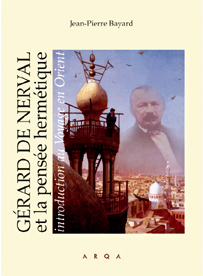 Where do you plan to go, in leaving my states? Asked King Solomon with feigned insouciance. To Tyr, the artist replied without hesitation: I promised to do so to my protector, the good king Hiram, who cherishes you like a brother and who for me has paternal regard. By your leave, I wish to bring a plan to him, with a view in elevation of the palace, the temple and the sea of brass, as well as those two great columns of bronze, Jakin and Boaz, which adorn the great portico of the temple.
Where do you plan to go, in leaving my states? Asked King Solomon with feigned insouciance. To Tyr, the artist replied without hesitation: I promised to do so to my protector, the good king Hiram, who cherishes you like a brother and who for me has paternal regard. By your leave, I wish to bring a plan to him, with a view in elevation of the palace, the temple and the sea of brass, as well as those two great columns of bronze, Jakin and Boaz, which adorn the great portico of the temple.
In this masterpiece of the Western Initiatic Tradition, which is Voyage in the Orient, Gerard de Nerval , in the fourth part of his work, restored here in extenso—the essential text so often cited partially, and nevertheless rarely read in its original context—the author, borrowing a mysterious path perfumed with all the incense of Egypt, recounts to us in the most beautiful manner, utilizing ancestral legends, certain travel narratives and certain hidden rituals, the unknown truths of certain secret mystagogies, instructing us notably in the grade of master.
Jean-Pierre Bayard in a luminous introduction unveils to us the nature of the scattered elements; biographic, historic, symbolic and initiatic, to better make us understand the dreamlike and inflamed prose of the mad writer of Hermetism.
We agree with Jean-Pierre Bayard, that: “Gerard de Nerval has bequeathed to us the indiscontinuous chain of traditional thought in the most limpid language while making us run the path of the sun from the poles.”
A mythic text of Gerard de Nerval—Voyage in the Orient—The Nights of Ramazan—Introduced with commentary by Jean-Pierre Bayard—Table of Contents/ Foreword—Jean-Pierre Bayard/Gerard de Nerval and hermetic thought—Introduction to Voyage in the Orient—Appendix I—Gerard de Nerval/ Voyage in the Orient; The Nights of Ramazan—(The Story Tellers))–Appendix II–Gerard de Nerval/ The Illuminati (Cagliostro and the Eighteenth Century)—Appendix III—Arcadia/Gerard de Nerval and the Secret of the Unicorn
230 pages – ISBN 2755100192
(extract)
To serve the designs of the great king Solomon, his servant Adoniram had renounced sleep, pleasures and the joy of feasts for ten years. Head of the legions of workers, who similar to innumerable swarms of bees competed to construct these hives of gold, cedar, marble and brass that the king of Jerusalem destined for Adonai and prepared proper to his grandeur; the master Adoniram passes his nights combining his plans and his days in modeling the colossal figures destined to adorn the edifice. He had established, not far from the unfinished temple, the forges, where the hammer ceaselessly resounded, the subterranean foundries, where the liquid bronze flowed the length of one hundred canals of sand, and took the form of lions, tigers, winged dragons, cherubim, or even of strange thundering spirits and distant races, half forgotten in the memory of man. More than one hundred thousand artisans under Adoniram executed his vast conceptions: the founders were of the number of thirty-thousand, the masons and stone carvers formed an army of eighty-thousand men, seventy-thousand manual workers aiding in transporting the materials. Disseminated in numerous battalions, the carpenters scattered in the mountains cut down the age-old pines all they way into the deserts of the Scythians, as well as the cedars on the plateaus of Lebanon. By means of the three-hundred-thousand attendants, Adoniram exerted discipline and now order among these worker populations, which functioned without confusion. Nevertheless the unquiet soul of Adoniram presided with a sort of disdain over some of these works, despite their greatness. To accomplish one of the seven marvels of the world seemed to him a paltry task. The further the work advanced, the more the weakness of the human race appeared evident to him, the more he moaned at the insufficiency and at the limited means of his contemporaries. Ardent in conceiving and even more ardent in executing, Adoniram dreamed of gigantic works, his brain boiling like a furnace, giving birth to sublime monstrosities, and while his art astonished the Hebrew princes, he along took pity on the works to which he saw himself reduced. He was a somber figure, mysterious. The king of Tyr had employed him and had made a present of him to Solomon. But what country did Adoniram come from” No one knew. He seemed to create all, to divine all and to do all. But what was his origin? To what race did he belong? That was a secret that was better guarded from all; nor he permit anyone to interrogate him on this point. His misanthropy made him as a stranger, a solitary in the middle of the lineage of the children of Adam, his brilliant and audacious genius placed him above men, who in no way did he feel to be his brothers. He shared in the spirit and the light and (…).”
Josephin Péladan and the ROSE+CROIX – Arnaud de l’Estoile
Arnaud de l’Estoile—Josephin Péladan and the Rose+Croix. Historic study on the Rosicrucian initiatic currents around the Sâr Péladan in La Belle Epoque —Afterword Jean-Pierre Bonnerot
 The initiate and genial visionary that was Josephin Péladan (1858-1918), founder of the Order of the Catholic Rose+Croix of the Temple and the Grail and founder of the celebrated Salons de la Rose+Croix, experienced at the age of 26 a certain instant celebrity with the publication of his first book, Le Vice Supreme. His adventurous life was inscribed paradoxically among occultism, symbolism, decadence, Catholicism and his highly singular activity in the breast of the literary, artistic and initiatic milieus of La Belle Epoque, which still remain today, in the eyes of contemporary critics, completely determinative. Nevertheless, certain aspects of his complex personality still remain quite misunderstood. Against any expectation, in a letter dated February 7, 1888, recently rediscovered in private archives, the Sâr Péladan defined himself as a “Christian kabbalist,” as does the bibliographic and contextual approach of this historic study on the Rosicrucian initiatory currents around Sâr Péladan, executed with assurance by Arnaud de l’ Estoile, the renowned writer and refined connaisseur of this period that he depicts in work after work, with the historic precision and the quality of an attentive researcher, meriting a very particular attention. “To present Josephin Péladan in a few lines, or in numerous pages, arises from a wager…” Jean-Pierre Bonnerot, President of the Josephin Péladan society confides in us, in his afterword to this work, it is nevertheless what the author succeeds perfectly in doing throughout this extraordinary voyage in an period when one rediscovers, among other things, the famous “War of the two Roses,” which sees a ferocious opposition between Stanislas de Guaita and Josephin Péladan, notably. At the dawn of his journey the work of Péladan fell into unmerited oblivion, as this work of Arnaud de Estoile recalls to us, which tends patiently with a polished erudition and with the presentation in facsimile of twenty-four unpublished letters of Josephin Péladan, to reweave the threads of an eternal and very much alive Rose+Croix.
The initiate and genial visionary that was Josephin Péladan (1858-1918), founder of the Order of the Catholic Rose+Croix of the Temple and the Grail and founder of the celebrated Salons de la Rose+Croix, experienced at the age of 26 a certain instant celebrity with the publication of his first book, Le Vice Supreme. His adventurous life was inscribed paradoxically among occultism, symbolism, decadence, Catholicism and his highly singular activity in the breast of the literary, artistic and initiatic milieus of La Belle Epoque, which still remain today, in the eyes of contemporary critics, completely determinative. Nevertheless, certain aspects of his complex personality still remain quite misunderstood. Against any expectation, in a letter dated February 7, 1888, recently rediscovered in private archives, the Sâr Péladan defined himself as a “Christian kabbalist,” as does the bibliographic and contextual approach of this historic study on the Rosicrucian initiatory currents around Sâr Péladan, executed with assurance by Arnaud de l’ Estoile, the renowned writer and refined connaisseur of this period that he depicts in work after work, with the historic precision and the quality of an attentive researcher, meriting a very particular attention. “To present Josephin Péladan in a few lines, or in numerous pages, arises from a wager…” Jean-Pierre Bonnerot, President of the Josephin Péladan society confides in us, in his afterword to this work, it is nevertheless what the author succeeds perfectly in doing throughout this extraordinary voyage in an period when one rediscovers, among other things, the famous “War of the two Roses,” which sees a ferocious opposition between Stanislas de Guaita and Josephin Péladan, notably. At the dawn of his journey the work of Péladan fell into unmerited oblivion, as this work of Arnaud de Estoile recalls to us, which tends patiently with a polished erudition and with the presentation in facsimile of twenty-four unpublished letters of Josephin Péladan, to reweave the threads of an eternal and very much alive Rose+Croix.
WITH A CAHIER ICONOGRAPHIC OF 62 PAGES FROM NUMEROUS DOCUMENTS FROM ARCHIVES & 24 UNPUBLISHED LETTERS OF Josephin Péladan, COMMENTED ON BY Arnaud de l’ESTOILE
TABLE OF CONTENTS
Introduction
Chapter I—Péladan, a life from the light to the shadow—Youth, literary glory and controversy—the twilit end of life of the Sâr
Chapter II—Péladan: from the Rose+Croix to the Catholic Rose+Croix
1) Rose+Croix—Historic recollection—2) Péladan and the Rose+Croix of Toulouse—3) The Order of the Catholic Rose+Croix of the Temple and of the Grail
Chapter III—The “war of the two roses”—1) The causes of the conflict—2) The Guaita-Péladan rupture—
Chapter IV—The salons of the Rose+Croix—1) Genese of the salons—2) The six salons of the Rose+Croix—Conclusion—Bibliography.
254 pages – ISBN 2755100540
(extract)
“This objection was courteous, but solemn. Despite that, the Sâr reacted very badly. In reprisal, he broke definitively while proclaiming himself Grand Master and Supreme Hierarch of the Third Order of the Catholic Rose+Croix. He named it then the “ Rose+Croix of the Temple and the Grail.” “War is declared between the two orders from which the expression “the war of the two roses” is taken up with relish by the Parisian chronicles of the period. Nevertheless, the relationships remain relatively cordial and Péladan continues even to participate in the activities of the Kabbalistic Order of the Rose+Croix in his role as “Roman Catholic legate to the journal Initiation.” But, in the Initiation of June, 1890, he inserted an announcement where he went back to his resignation from the Supreme Counsel. Considering that he had been the first to render his glory to the “Holy Magic,” and that the hermetic current has become powerful and victorious, he announced to his five peers on the Supreme Counsel that the hour of his personal exodus had sounded. He justified himself by declaring (…) The most evident wisdom inspired us while deciding that we would detach from the Rose+Croix an intellectual third-order for Roman Catholics, Artists and women. I leave my place among you as one of the six, in order to take it up again in the quality of an ultramontane legate. Still associated with your studies, I am no longer in solidarity with your works: Elector to the same Empire, I am seated still, but only as a witness; and it is to the Sainte Eglise that you give my voice in the Supreme Counsel. I will not explain in this public document my R+C+C, which has for its grounds the theme of the Grail and pure prayer: to the cross through the rose to the rose through the cross; in eà, in eis gemmatus resurgam. Here, I only wish to bear witness(…).”
Oral Teachings of Monsieur Philippe de Lyon: Envoy from Heaven
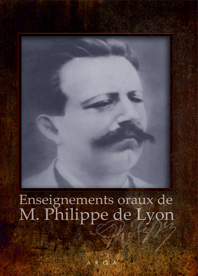 This long manuscript, entirely consecrated to the oral teaching of M Philippe de Lyon, a teaching given over the four years from 1893 to 1897, was originally attributed to a silk-worker from Lyon, who remained totally anonymous. The manuscript transcription, restored here in its entirety and in its chronological continuity, was later attributed to François Galland (1883-1969), a friend of Jean Chapas (1863-1932), the faithful disciple of the celebrated healer of Lyon. In this exceptional document are recovered the essential teachings of Philippe de Lyon, traversing all of Christian mysticism, which the thaumaturge approached almost daily and continuously deepened with a simplicity and a humility that commanded the most profound respect in his auditors. The subjects are the Creation, the hidden nature of the four Gospels through a personal exegesis, the distinct parts of Being, on reincarnation, on the progression of the soul, but also on apprenticeship in magnetic healing, on the spirit of prayer, on Good and Evil, on the Kingdom of God, on the Angels, on death…or more precisely, on life after death, etc. Certain discussions issued from this explanatory document were addressed to specific people who had a particular question or needed a specific care and should not be generalized; others are truly usable by everyone; thus advised the reader will need to exercise discernment. In the framework of the current edition, it also appeared helpful to the reader to enrich this oral teaching of Philippe de Lyon with other talks and certain major texts of those close to the Master. Included are numerous archival documents among them an unknown letter of Philippe de Lyon bearing his seal as a Russian doctor, two unpublished portraits of M. Philippe, eleven letters concerning M. Philippe at the Russian court, some letters from Tsar Nicholas II to the Tsarina, as well as some pages, presented for the first time from a notebook of M. Philippe, secretly encoded.
This long manuscript, entirely consecrated to the oral teaching of M Philippe de Lyon, a teaching given over the four years from 1893 to 1897, was originally attributed to a silk-worker from Lyon, who remained totally anonymous. The manuscript transcription, restored here in its entirety and in its chronological continuity, was later attributed to François Galland (1883-1969), a friend of Jean Chapas (1863-1932), the faithful disciple of the celebrated healer of Lyon. In this exceptional document are recovered the essential teachings of Philippe de Lyon, traversing all of Christian mysticism, which the thaumaturge approached almost daily and continuously deepened with a simplicity and a humility that commanded the most profound respect in his auditors. The subjects are the Creation, the hidden nature of the four Gospels through a personal exegesis, the distinct parts of Being, on reincarnation, on the progression of the soul, but also on apprenticeship in magnetic healing, on the spirit of prayer, on Good and Evil, on the Kingdom of God, on the Angels, on death…or more precisely, on life after death, etc. Certain discussions issued from this explanatory document were addressed to specific people who had a particular question or needed a specific care and should not be generalized; others are truly usable by everyone; thus advised the reader will need to exercise discernment. In the framework of the current edition, it also appeared helpful to the reader to enrich this oral teaching of Philippe de Lyon with other talks and certain major texts of those close to the Master. Included are numerous archival documents among them an unknown letter of Philippe de Lyon bearing his seal as a Russian doctor, two unpublished portraits of M. Philippe, eleven letters concerning M. Philippe at the Russian court, some letters from Tsar Nicholas II to the Tsarina, as well as some pages, presented for the first time from a notebook of M. Philippe, secretly encoded.
266 pages – ISBN 2-7551-9961-3
(extrait)
April 25, 1849, at three o’clock in the morning, born at Loisieux near Yenne, a being, as singular as he was extraordinary: Anthelme Nizier Philippe. His arrival was implicitly predicted by the seer Louis-Michel de Figaniere in his “Key of Life,” and the Priest of Ars, it appears, confided to his mother that the child will be a “high being.” In conformance with the “intersigns,” that the Doctrine of Signatures, dear to Paracelsus, invokes, can one not see there the Law of the Heavens in action or Heavenly Law? Another equally strange thing: his parents names were Joseph (Joseph Philippe 1819-1898) and Mary (Marie Vachod 1823-1899). Later the disciple he most loved was called John… Could all these similarities be attributed to pure coincidence!
At a very young age, he accomplished miraculous healing without any other visible procedure but prayer.
At the age of fourteen, the young Anthelme came to Lyon. From 1870 he cared for the sick. On October 3, 1877, he married Jeanne Julie Landar (1859-1939).
His activity was directed toward the most modest as well as toward the great of this world in order to soothe suffering—physical, moral and spiritual—and his reputation spread way beyond the frontiers of France (to Italy, Montenegro, Tunisia, Russia, etc.) at a time when official medicine was completely incapable of understanding such a personage…. With popular recognition, he earned the soubriquet of “Father of the poor.” Certain occultists and spiritualists of renown in La Belle Epoque, such as Paul Sédir (Yvon Le loup), Phaneg (Georges Descormiers), Marc Haven ( Doctor Emmanuel Lalande) or even Papus (Doctor Gérard Encausse) left everything behind in order to follow in his exceptional wake. His good nature, his excess of generosity impressed them greatly. He was solicited for all sorts of problems: success in career, success of an enterprise, safe protection for a soldier, solution of a technical problem, appeasement or consolation of a soul crisis, for hope…. Mothers of families watched him from the street-corners. He paid the rents of dozens, lavished extreme attention on old men and the infirm, helped the timid and the humble, was patient with the importunate and pseudo savants…. He asked for no personal recompense, but demanded only in return that the petitioner repay Heaven by giving up something of his own:a meal, some sort of donation, reconciliation, abandonment of a legal process, adoption of orphans, greater control of his language, etc. This mystic and thaumaturge was an authentic envoy of Heaven on a mission from God, a representative of Divine Providence on earth as Sédir reports in his Initiations:
“All the marvels worked by such saints as Vincent Ferrier, François de Paule, Joseph de Cupertino, the priest of Ars, by the trained willpower of people such as Bernard de Clairvaux, Francis of Assisi or Joan of Arc, I have seen him accomplish them; miracles flowered around his steps; they seemed natural, unmistakeable, certain, and provoked by nothing other than prayer.”
Symbolism of the Round Table in Arthurian Legend – Georges A. D. Martin
“The initiatic process rigorously reproduces the cosmogonic process; the total realization of the possibilities of being is accomplished necessarily by passing through the same phases as that of universal existence.” (René Guénon)
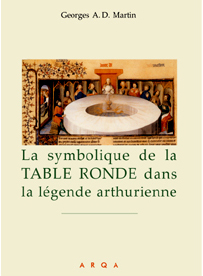 Beyond the representation situated in the Great Hall of Winchester, Georges A. D. Martin proposes to us a magnificent reflection, drawn from the Arthurian legends, on one of the major symbols of the Christian Occident. For Georges A. D. Martin, the Round Table is not only a mythic and imaginary object, but also a highly symbolic representation of the metaphysics of cosmic forms. So, let us not forget that for René Guénon, the Holy Grail is an image of heaven on earth, that is to say—a zodiac…. And the Round Table? A privileged place where the wandering knight is seated, having attained the ultimate goal of his quest…. But at what price? It is this that Georges A.D. Martin recounts for us, without any artifice, thanks to history, legend, and the semantics of symbolism, which supplies us in this little work with the substantive keys, a grid for an original reading which will surprise even the seasoned reader
Beyond the representation situated in the Great Hall of Winchester, Georges A. D. Martin proposes to us a magnificent reflection, drawn from the Arthurian legends, on one of the major symbols of the Christian Occident. For Georges A. D. Martin, the Round Table is not only a mythic and imaginary object, but also a highly symbolic representation of the metaphysics of cosmic forms. So, let us not forget that for René Guénon, the Holy Grail is an image of heaven on earth, that is to say—a zodiac…. And the Round Table? A privileged place where the wandering knight is seated, having attained the ultimate goal of his quest…. But at what price? It is this that Georges A.D. Martin recounts for us, without any artifice, thanks to history, legend, and the semantics of symbolism, which supplies us in this little work with the substantive keys, a grid for an original reading which will surprise even the seasoned reader
Table of Contents/ Once upon a time—Historicity and Predestination—The Round Table
The circle was initially composed of twelve Knights, but very quickly their number was increased by admission to twenty-four. Some spoke of forty-nine with an empty place, belonging to the Holy Spirit. Thus a fiftieth is proposed, the natural number imposed by the triangle-rectangle, source and birth of all things. The fiftieth guest was the Knight of the number of the Spirit who must find the Grail and by his internal virtues obtain illumination; a duty for which he must remain courageous and chaste. From the allegory or multiple symbols, from the rotundity of the Table, like the world and the circle, that suggest that the image of the solar crown must be mentioned, a “Feminine” entity, thus sexual of the circle and of the ring, a postulate opposed to the “Masculine,” of the sword and of the warrior, who guards here a priori more that ever his great ancestral prerogatives with the Round Table of the Quest. Onto the allegories of the quest are grafted the fraternal circle of the faithful; certain knights of Arthur’s realm, the military “Order” indispensable to the King; for his companions, an alliance of warriors and of invisible forces destined to furnish the necessary energy to the King and to his hardly commonplace enterprise. The perilous seat of the Round Table in stone which “cries” and is riven appeals very particularly to a pre-Celtic primitive situation as do the Lance, the Sword and the Cauldron, which are recuperated by the Celtic culture before being Christianized later. With the narratives of the Arthurian legend and its numerous correspondences from a world almost forgotten by us, one must not neglect that at the famous battle of Tailta near Stonehenge, the Tuatha Dé Danann (the people of the goddess Dana) had been conquered by the Gaëls, that is to say, the Celts. At this distant period, it was convenient that the Gaëls should guard the surface of the Earth, while the Tuatha Dé Danann guarded the underground of the earth, the lakes and the mounds, as well as the distant islands on the sea! In this brutal changeover of civilization probably near a reality, wherever the ancient does not disappear entirely, a shamanic and druidic comportment will permit glimpses through the access between these two worlds, veritable magic portals onto the Beyond. It is thus that the stone of Fâl at Tara, religious and symbolic capital of primitive Ireland, served at ceremonies of investiture of sovereignty. The Stone would designate the newly chosen one, the Supreme King, by a cry… while the stone which is split opens up into two. The search for a Cor (horn),which prolongs the “Cry of the stone,” announcing this election will also be the subject of a quest similar to that of the Grail in an ancient narrative. At the Round Table, the Cry of the stone is replaced by the names of the Knights who are inscribed spontaneously in the stone of each seat. The stone which is split in the ceremonial context of the Round Table (…).”
The Symbolism of the Grail – Gil Alonso-Mier
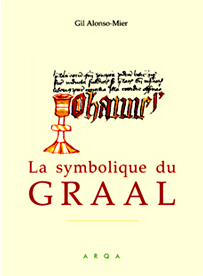 Whether it be cup of life, cauldron of eternal life, vase of plenitude, sacred crater, chalice without voice or speech, ark outside of time, space and measure, emerald of 144 facets fallen from the crown of the Archangel of Light, stone fallen from Heaven, or even a simple sign of pure solar initiation…, baptism of fire, immaculate heart, celestial Pentecost, divine effluvia, vertigo of Love, Holy Spirit, Cloud over the Sanctuary, invisible and hidden Center, inaccessible even to one slightly profane, Pole without return, Rose vermeil…. What truly is the Grail, without these convenient definitions? And especially which of it is truly its universal dimension beyond the clouds circumscribing our sublunary world? A tortured world imprinted co-substantially with materials hidden from human incarnation…. What is the symbol of the Grail? A Grail born by the angels of Light? This is what author Gil Alonso-Mier devotes himself to describing minuteously in this book, by means of a number of references swirling around the Round Table of the Knights in quest of Consciousness. For that is what it is really about, about an awareness lost since the night of time; an illuminated knowing which only asks to be rediscovered by the passionate magic of the Grail of love, proper to seal in the the signs which make of books the natural virtue of a metaphysical symbol. propre à sceller dans les signes qui font des livres, la vertu naturelle d’un symbole métaphysique.
Whether it be cup of life, cauldron of eternal life, vase of plenitude, sacred crater, chalice without voice or speech, ark outside of time, space and measure, emerald of 144 facets fallen from the crown of the Archangel of Light, stone fallen from Heaven, or even a simple sign of pure solar initiation…, baptism of fire, immaculate heart, celestial Pentecost, divine effluvia, vertigo of Love, Holy Spirit, Cloud over the Sanctuary, invisible and hidden Center, inaccessible even to one slightly profane, Pole without return, Rose vermeil…. What truly is the Grail, without these convenient definitions? And especially which of it is truly its universal dimension beyond the clouds circumscribing our sublunary world? A tortured world imprinted co-substantially with materials hidden from human incarnation…. What is the symbol of the Grail? A Grail born by the angels of Light? This is what author Gil Alonso-Mier devotes himself to describing minuteously in this book, by means of a number of references swirling around the Round Table of the Knights in quest of Consciousness. For that is what it is really about, about an awareness lost since the night of time; an illuminated knowing which only asks to be rediscovered by the passionate magic of the Grail of love, proper to seal in the the signs which make of books the natural virtue of a metaphysical symbol. propre à sceller dans les signes qui font des livres, la vertu naturelle d’un symbole métaphysique.
Gil Alonso-Mier, member of C.E.N.A., Center for Studies of Normand Anthropology, recounts to us here, in the manner of a celtic bard, in this short text where the Christian mystic disputes with a faultless erudition its letters of nobility, the history of a symbol, beyond doubt, the most mysterious in all of the Western Tradition.
52 pages
The Mystery Tribe of the TUATHA Dé DANANN
Solar Mysticism and the Art of War – Myriam Philibert
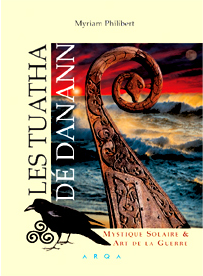 One day, the gods came to earth… Did they remain immortal here, or did they integrate into the sphere of the humans, of the animal-totems and the trees, scratched with oghamic signs, the law to which they had to submit. What was, therefore, this mysterious tribe, come from the depth of the ages, determined to conquer the world by iron as well as by their solar initiation? We don’t really know where the Tuatha dé Danann were residing—far away—in the northern isles, learning science, magic, Druidism and High Wisdom…. The lance of Lug and the sword of Nuada were for them always victorious over blood-thirsty soldiers, certain evanescent beings and lunar monsters. The Stone of Destiny cried out under each king who governed Ireland… and the cauldron of Dagda offered to the conquering hero the drink of eternal resurrection…
One day, the gods came to earth… Did they remain immortal here, or did they integrate into the sphere of the humans, of the animal-totems and the trees, scratched with oghamic signs, the law to which they had to submit. What was, therefore, this mysterious tribe, come from the depth of the ages, determined to conquer the world by iron as well as by their solar initiation? We don’t really know where the Tuatha dé Danann were residing—far away—in the northern isles, learning science, magic, Druidism and High Wisdom…. The lance of Lug and the sword of Nuada were for them always victorious over blood-thirsty soldiers, certain evanescent beings and lunar monsters. The Stone of Destiny cried out under each king who governed Ireland… and the cauldron of Dagda offered to the conquering hero the drink of eternal resurrection…
Setting out to explore in depth the ancestral myths as well as the historic truth of this enigmatic Celtic tribe, Myriam Philibert, with unequaled verve, brings to life in this book the most unknown facets of the Irish epic, blending with talent the accounts and legends of the Tuatha dé Danann and the archeological traces, demonstrating with assurance the proven existence of these poorly understood people. To the sounds of the harp, the bards sang the epic of Cuchulainn and Myriam Philibert, professor of prehistory, an attested guide into the Celtic arcana, initiates us savantly into the supreme quest—that of the solar mystique and the art of war….
This exceptional work, made from the revived embers of an ancient traditional heritage, calligraphed like the book of Kells, with immaculate swan plumes; with a glossary at the end of the work of more than 200 names of gods, world rulers, heroes of forgotten legends, fairies, magicians and sirens, druids and bards, enchanters and of the priest of a hundred names will not leave indifferent the sincere seeker in quest of truth, desirous of rejoining the Sidh at the infinite megaliths, the drowned continent and the White World, forgetting that it will be battle fields and endless combats….
Table of Contents
I. THE FRAMEWORK OF THE IRISH EPIC—The archaeological facts—The infinity of megaliths—The Valley of the Boyne, residence of the gods—The remarkable proto-historic sites—Entry into history;
II. BIRTH OF AN EPIC OR A HERO—The Irish Epic re-transcribed—The Book of Invasions—Correlation between the chronological systems—Birth of the mythology—Conception and miraculous birth—Predestination of the heroes—Appendix: Resume of Irish history
III. HEROIC INITIATION AND THE ROYAL WAY—The heroic initiation of Cuchulainn—The Fianna—The hero in battle—Royal initiation—Kings and solar avatars—Heroes and antiheroes;
IV. THE WORLD OF MAGIC—Shamanism—Metamorphoses and Mutations—Sacerdotal Initation—Some Prestigious Druids—Cuchulainn and the Sorcerers—Poets and Brads—The talents, Gifts and Tours of Craft Competencies Tours de Metiers
V. SOVEREIGNTY AND/OR COSMIC UNION—The Lunar Lady—The Earth Goddess— Initiation into Love—Sovereignty and Royal Initiation—Young maidens and Initiation into Love—The loves of Cuchulainn;
VI. War without Pity—The Divine and Human Arms—The Battles of Mag Tured—The Heroes and their Prowess—The Wanderings of the Battle of Mag Tured—The End of the Battle of Mag Tured—War in the Cycle of Ulster—The Exploits of Cuchulainn—The Duel of the Two Bulls
VII. PASSAGE THROUGH DEATH AND THE END OF THE WORLD—The heroes and the Sidh—The Women and the Sidh—The Mound and the Sidh—The Sacrifice and the Sidh—The Distant Islands—The Feast of Eternity—The End of the World
VIII. GLOSSARY OF THE HEROS AND OF THE GODS
220 pages – ISBN 2755100419
(extract)
One day, the gods came to earth. Did they remain immortal? Did they integrate into the sphere of human beings, animals and trees, to whose law they had to submit? The stage is set—a pitiless world where war must rage and where heroes become gods again in a solar theophany, or more precisely, lunar. They penetrate into the White World, that they have miraculously attained at the price of unsustainable and cruel trials. Heads have fallen and the cauldron of resurrection is no longer there to bring them back to life and launch them again on a new day of combat. An ultimate confrontation took place between them and their alter ego. To win or to lose—does it make a difference? It suffices to strike a single blow and, for eternity, one gains the title of “sovereign of the world of the Abyss” and the enjoyment of a marvelous paradise, situated on an inaccessible island and …).”
The Gods of the Gauls – Henri Hubert
Preface by Myriam Philibert
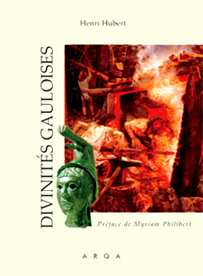 “The word ‘Druid’ had disappeared from the vocabulary during the several centuries following upon the persecutions perpetrated by the first emperors.” Myriam Philibert—
“The word ‘Druid’ had disappeared from the vocabulary during the several centuries following upon the persecutions perpetrated by the first emperors.” Myriam Philibert—
They are known under the names of Lug, Esus, Cernunnos, Toutatis, Belisama, Belenos, Kronos, Taranis, Silvain… But who were truly the gods of the Celts, the Iberians, the Ligurians and the Thracians? Of the Germans and of the Scythes?
In this study of 1925, republished by Editions Arqa, Henri Hubert (1872-1927), archeologist and recognized historian, great specialist of the Celtic world, presents to us, with an unparalleled erudition, the pantheon of those that are called barbarians and who have no other name than that… At the source of the Druidic tradition we rediscover with the author Sucellus, the god of the mallet, Nantosuelta, the goddess of the hive, Epona, seated on her courser of wind, without forgetting the gods of the other world.
In a useful and savant preface, Myriam Philibert, Doctor of Prehistory, citing the Bardic Triads, restores fully the magic of this forgotten text, and enlightens in the best manner who all these Gallic divinities are—lovingly—within the circle of Gwenved.
Table of Contents
Divinities gallic—Sucellus & Nantosuelta, Epona, God of the Other World
98 pages – ISBN 2755100168
(extract)
“The Gauls made great use of barrels. Perhaps they may even claim the right to their invention. That the barrel has given, in their familiar arts, an emblem to one of the most particular of their national gods, one will not be astonished to learn, perhaps with good reason. But what does this barrel contain? Wine? It is possible. Between the hands of Silvin (and Silvin has lent to the god of the mallet his name, his attributes and perhaps a little of his person) is seen a bunch of grapes. And what about beer? That is more likely; it suits better the small size of the barrels and it is more gallic. The Gauls, drinkers of beers, while fabricating several kinds and they have bequeathed some words of their own invention to the vocabulary of the breweries. I have even come to believe that they invented the use of adding herbs in beer and that they have shown honor to the god of the hammer, the god of beer. They knew the houblon and the name of houblon, humulus lupuus, readily bringing to mind the wolf that was the familiar of Silvin the god of the hammer, if indeed this wolf were not a dog. Among all kinds of beers they fabricated hydromel. If the god of the mallet, god of the barrel is the god of beer, it is completely appropriate to the Gallic religion that his spouse be a goddess of hydromel and preside as such over the harvest of the honey, the bees and the opening to the hive. That the god of the mallet or hammer, the use of which the gallic monuments allows us freedom to imagine at will, is very much a god of beer, the mythology of the insular Celts gives us full satisfaction on that subject. Several personages from Irish mythology are the “strikers,” armed with bludgeons, and hammers. One has compared Sucellus to the Fomorian Balar, grandfather of the god Lug. I compare him rather to the divine forger Goibniu, who is part of the Tuatha De Danann. It is he who prepares for the gods, the famous “feast of Goibniu,” “fled Goibnenn”, feast or drink, for there it is a question of drinking the “deoch,” which renders one immortal. However, this drink of immortality, was a beer, which overflowed from the other world, the world of the gods and of the soul, a marvelous cauldron, object of the desires of all the great heroes. The forger Goibniu had more than one career, he was also a builder. As such, he is confused in mythology with another striker, Dagda, also a great drinker and eater who also possessed a cauldron the contents of which he can empty by a d’un trait (at one go), whether porridge or beer. Dagda and Goibniu built for Balar. The three great “strikers” are thus also close to one another. However, the forger god is not specific to Ireland. The Gallic Mabinogian acquaints us with one Govannon, also a forger. Govannon is the uncle of Llew, that is to say, Lug, whose grandfather is Balar. Govannon dates from way back for among the place-names proven to be Breton by Latin geography, we find a Gobanniodunumm “fortress of the forger.” Breton is often the same as Gallic.
In any case, Gaul proper, lacking a divine name which falls to Govannon et to Goibniu, has left us certain theophoric names. Gobannicnos is certainly one of them (the son of Gobannos); Gobannitio, the uncle of Vercingetorix, funishes another example. This forger god, cousin of Goibniu goidelic, whose existence one is justified in supposing, he is doubtless the god of the mallet, patron of forgers and who (…).”
The Symbolism of the Letter G – Edouard de Ribaucourt
Preface to the republication of The Symbolism of the Letter G by Edouard de Ribaucourt – Second edition.
 One of the most visible personalities of his time in the Traditional milieu, high grade of the Grand Orient of France GODF (GODF) then founder of the Independent and Regular Grand Lodge of France (GLIR) ancestor of the National Grand Lodge of France (GLNF), Édouard de Ribaucourt by means of an educated analysis of different languages, Greek, Hebrew, Phoenician, as well as the symbolism of numbers 3, 5, and 7, invites us to follow him in his 1907 study, today republished with commentary by Editions Arqa.
One of the most visible personalities of his time in the Traditional milieu, high grade of the Grand Orient of France GODF (GODF) then founder of the Independent and Regular Grand Lodge of France (GLIR) ancestor of the National Grand Lodge of France (GLNF), Édouard de Ribaucourt by means of an educated analysis of different languages, Greek, Hebrew, Phoenician, as well as the symbolism of numbers 3, 5, and 7, invites us to follow him in his 1907 study, today republished with commentary by Editions Arqa.
“The flaming star was once the image of the son of the sun, author of the seasons and symbol of movement, of Horus, son of Isis, of the first matter, inexhaustible source of life, this spark of fire increate, seed universal of all beings. In the middle of the star appears the letter G.”
Jean-Marie Ragon–What does that G denote?
Associated with the flaming star, the letter G, a circle, with an opening, separated in two at its center, sets the tone of an esoteric scholasticism from between the two columns, which, without contradicting itself, transmits and protects from generation to generation the metaphysical truth situated upstream from the revealed obediences and the communally practiced rituals. The letter G, that historians of the Royal Art have seen appearing at the center of the flaming star since 1737, goes, from the Age of Enlightenment, as an archetypal element of the Temple to be rebuilt to become the icon of symbolic thought, par excellence, a mute language if ever there were one, to better impress upon the awareness of those concerned the spiritual conception of the Primordial Tradition. This, when Masonic, has its arcana, its grades, its degrees. Its truth is to initiate in essence the profane who may seek it. Subtly. In a voluntary and sacred absorption whose sole goal is the veneration of the mysteries in the true athanor of the Lodge. And, authentic Initiation, is it not assuredly, as Mircea Eliade (1907-1986) suggests, “the most significant spiritual phenomenon in the history of humanity”? The letter G, fifth consonant of the Latin alphabet (the numbers 3, 5, and 7 are associated with it), will take on, as it must, according to its different functions in the practice of different grades, a specific resonance. It is the initial of the fifth science, Geometry, otherwise known as the Art of Drawing, associated with the symbolism of numbers as they are taught in the Tradition of the Compagnonnage (Medieval operative masons of France) This is corroborated elsewhere and rarely cited by the exegetes, in the Greek etymology of the words Geometry and Gematria, which fused, symbolically instruct well the Omnipotence of the Word within the breast of the Way of Numbers, a dry way, certainly, but oh how gratifying for the wise reader who will discover in the tormented wakes of Wronski (1776-1853) or of Lacuria (1806-1890) the enlightening and luminous flares of the Pythagorean Tradition. And if the letter G is also an initial, for the Anglo-Saxons, of the Great Architect of the Universe, (Gad, Gut, Gott, God, Goda), one will not lose sight, according to the Cabala (with a “C”) (2) that its direct relationship to the Hebraic Iod, first letter of the Tetragrammaton, is not only homophonic, between God and Iod, but also perfectly symmetrical, in a symbolism of the first degree. Nevertheless, to associate God, that is to a God (but which God?) with the God of the Hebrews YHVH, remains, above all, something to be demonstrated rather than to be enunciatedi.
G, the letter that can sometimes be found symbolically as the initial of the word Grail, which is not without interest, signifies also Generation and the grade of Master.
“Let us grieve….” Lamentations, admittedly for nature naturing that we must rediscover again and again; a long lament as well for Anima Mundi, universal web and black virgin, soul benefactress sublimely healing for a fallen world where obscurantism reigns today among the most benighted, lacking any discernment. Lamentations finally, in the direction of a Veiled Isis, unveiled, whose son the Freemason is and a son eternally inconsolable…
This letter G, known to all the Western initiatic traditions and assimilated in the same manner in a sacred ternary by others, possesses also in itself, as shown to us in this short study of Edouard de Ribaucourt, a powerful symbolic character that identifies without imputation certain initiates of the solar way. Thus the poet Gérard de Nerval (1808-1855), who was not a Freemason (4) but doubtless a member of the very secret Societe Angelique, seeds his works with constant references to this letter G, whose profound symbolism was certainly not unknown to him, and which he associated, for himself, according to the language of the birds, with the family of Jays (Geai in French), in order to inscribe his name in a rare Geai or better yet, G rare. A geai, that he designed in a cage to signify the imprisonment of the soul in the breast of the body. And still others who, from Rabelais (1494 -1553) to Grasset d’Orcet (1828-1900), attracted the interest of the seeker to the specificity of this letter. But also to remain, for the moment in masonic symbolism, let us not omit, before concluding, to point out that the flaming star, associated with the letter G, was also, highlighted on vellum, according to a particular symbolism, in order to represent identification with the prime matter in the alchemical rituals
attributed to the Baron de Tschoudy, a sufficiently singular thing requiring us to pause over it for a few
moments (5).
Edouard de Ribaucourt ( 1865-1936 )
This high-grade Freemason, 31st degree of the Grand Orient of France, born in Switzerland to French parents, professor of natural history and author of this work, is not unknown to historians of freemasonry since he was rediscovered in 1913, on November 5 to be exact, as founder of the GLIR, initials of the Independent and Regular Grand Lodge of France and the French colonies which became in 1948 the GLNF, National Grand Lodge of France (6). This new obedience, schismatic branch of the GODF some would say, where returning in principle in the circle of the United Great Lodge of England through a voice not “substituted,” let us say, by others, proposed to its members: “a belief in God, expressed under the name of the Great Architect of the Universe, a swearing of oaths on a sacred book as well as a symbolic and spiritual work in the lodge excluding categorically any exchange of political or religious agreement.” Eduouard de Ribaucourt, brother of the Grand Orient of France therefore, after an exemplary life, was aged 55 in 1907 when he wrote this little opuscule (7). His personal itinerary led him then through certain lines to clearly specify his judgment concerning his perception of the Great Architect of the Universe, mouthpiece as he is also for the GODF, so this note can be found at the end of the volume:
This is why the majority of FF…MM…, in the world speak of the Great Architect of the Universe. The G…O…, in abolishing this symbol, has never understood by that to combat or beat out one of the traditions of universal masonry; it has wished to remove from our adversaries a pretext for a sometimes dogmatic equivocation and to give the maximum liberty to its adherents. That is what clearly comes out in the declaration of the Counsel of the Order of September 20, 1906 thus conceived:
“Respectful of all beliefs as of all unbelieving seekers of truth enlightening us solely with the lights of reason and leaving to others the right to faith, we are opposed with all our might to any attack the freedom of thought can receive.”
As can be seen, this citation, with the benefit of a distance in time, merits a certain rereading. (8)
At bottom, this work, a masonic testimony, in filigree, from either a troubled or renewed period, however one may wish, without being exhaustive certainly over all of its symbolic propositions, poses the stages of a study on the letter G, a study above all essential for the Freemason of any degree or of any obedience and raises questions on the difficulty of discerning a sign and this despite the approach or erudition that anyone may possess in this specific domain.
In finishing, let us add, in these times of confusion (and that seems to us essential to be said as well as to be written), that a symbol, if it is the Traditional place of all possible encounters in the heart of a semantic field, accepted by all, graphic and semiotic, unconscious and collective, moving and reverberating, still can never be just “a big grab-bag” into which can be put anything one wants to see there or believes to be connected with it.
Whence the usefulness, sometimes, often, of going back to the source.
Elements of Martinist Symbolism –Preface by Jean Iozia – Anonymous
 “The books that I have written have no other goal than to engage the readers to let go of all books, without exception, including mine.” (Louis-Claude de Saint-Martin)
“The books that I have written have no other goal than to engage the readers to let go of all books, without exception, including mine.” (Louis-Claude de Saint-Martin)
“If today, complete studies and erudite essays on Martinism and Martinezism are available, paradoxically, we lack introductory works. This book is thus welcome, as it can be usefully recommended to anybody, ignorant of Martinism who desires to learn about it. The text, signed
B. de M, treats of Martinist symbolism. It is complemented by a lengthy preface by Jean Iozia who recalls the history of Martinism since Saint-Martin and Martinez de Pasqually as the genesis of the Martinist Order at the center of the agitated occultism of La Belle Epoque.” (Rémi Boyer)
“Elements of the Martinist Symbolism,” a short typewritten text, came to us according to the ways of the Tradition. Presented here in its totality, it has been very lightly revised at the end of the edition. Certain parts, annotated on the opposite page, erased or altered, were again added back or corrected, to best preserve its spirit. The few necessary elements, that are revised, in no way distort the meaning of the book, but have for their sole purpose to respect a better textual coherence. The author, an unknown person, who drafted this introductory work nearly a half century ago, belonged unquestionably to a Martinist group, the name of which we discovered was “Holy Group John.” In the same vein as The Symbolism of the Letter G by Édouard de Ribaucourt, published in 1907, and republished by Éditions Arqa in 2004, we present today in this new edition, this study, written in 1961, which no doubt was used originally as a communication with an initiatory purpose, during a Martinist meeting. This new edition is enriched with a preface by Jean Iozia
Summary / Preface by Jean Iozia—Introductory Remarks—Initiation—The Temple—The Symbols
80 pages
L’ABC de RLC – Encyclopedia of Rennes-le-Chateau
Patrick Berlier, Christian Doumergue, Daniel Dugès, Thierry E. Garnier
Préface de Michel Vallet
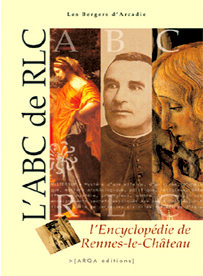 It took more than three years of study and work by four authors: Daniel Dugès, Patrick Berlier, Christian Doumergue, Thierry E Garnier: assisted in their task by eight friends and collaborators of renown, Franck Daffos, Michel Vallet, Antoine Captier, Jean Brunelin, Gil Alonso Mier, Georges A D Martin, Alain Caradec, Michel Crozet, and others still, in order to accomplish this encyclopedia consecrated to the mystery of Rennes-le-Chateau. With more than 800 definitions and key words and 940 photos and documents, this eminent summa will remain in the history of Rennes-le-Chateau as one of the major building blocks, consecrated to the entire edifice that constitutes all the research on this tiny village in the Aude Valley. Far from being a compilation of scattered notes, this encyclopedic study, conducted by the hand of a master, owes much to the talent of his authors who spared no effort to re-frame a complex and savant truth, far from local quarrels and partial studies. This leading encyclopedia, a factual work, unbound by taboos of any kind, something that has been unmistakably lacking in this field of study, is finally published thanks to Editions Arqa. It constitutes a bank of incomparable facts and is meant to serve as a reference for the reader, as well as for the researcher, whether neophyte or confirmed. In the ABC of RLC will be found numerous sources from historical, literary, graphic, cartographic, and photographic archives, rare items, that is to say, totally unpublished, that make of this remarkable volume, not only a unique work but also permitting the collection in one mega-volume of very important supplementary documents for all the curious incorrigibles in quest of knowledge. History, Geography, Toponymy, Symbolism, Hermetism, Traditions, Secret Societies, Beaux Arts, Literature, Biography, Research findings, implement the various departments of this encyclopedia, that will be consulted wisely, gluttonously devoured or gleaned from as needed, in the shadow of the Tour Magdala.
It took more than three years of study and work by four authors: Daniel Dugès, Patrick Berlier, Christian Doumergue, Thierry E Garnier: assisted in their task by eight friends and collaborators of renown, Franck Daffos, Michel Vallet, Antoine Captier, Jean Brunelin, Gil Alonso Mier, Georges A D Martin, Alain Caradec, Michel Crozet, and others still, in order to accomplish this encyclopedia consecrated to the mystery of Rennes-le-Chateau. With more than 800 definitions and key words and 940 photos and documents, this eminent summa will remain in the history of Rennes-le-Chateau as one of the major building blocks, consecrated to the entire edifice that constitutes all the research on this tiny village in the Aude Valley. Far from being a compilation of scattered notes, this encyclopedic study, conducted by the hand of a master, owes much to the talent of his authors who spared no effort to re-frame a complex and savant truth, far from local quarrels and partial studies. This leading encyclopedia, a factual work, unbound by taboos of any kind, something that has been unmistakably lacking in this field of study, is finally published thanks to Editions Arqa. It constitutes a bank of incomparable facts and is meant to serve as a reference for the reader, as well as for the researcher, whether neophyte or confirmed. In the ABC of RLC will be found numerous sources from historical, literary, graphic, cartographic, and photographic archives, rare items, that is to say, totally unpublished, that make of this remarkable volume, not only a unique work but also permitting the collection in one mega-volume of very important supplementary documents for all the curious incorrigibles in quest of knowledge. History, Geography, Toponymy, Symbolism, Hermetism, Traditions, Secret Societies, Beaux Arts, Literature, Biography, Research findings, implement the various departments of this encyclopedia, that will be consulted wisely, gluttonously devoured or gleaned from as needed, in the shadow of the Tour Magdala.
684 pages, 4-color cover
813 entries in dictionary format
85 plates of full-page illustrations
1000 photos and archival documents
Discover more about L’ABC of RLC – L’ENCYCLOPÉDIE of Rennes-le-Chateau on its own site :http://abc-de-rlc.org/ – ISBN 2-7551-0031-1.
(extract)
From Preface by Michel Vallet
“A work which will meet its deadline” two years before that, Thierry Emmanuel Garnier, Grand Nautonier of Editions Arqa, informed me about the sweep of a project which was then in the course of being realized: that of endowing the affair of Rennes-le-Chateau with a veritable encyclopedia!
That is to say, a vast inventory of all the known elements, as much on the human level, historic, ethnographic, and geographic. Knowing the extent of the task, I told him how great his ambitions was, but especially how praiseworthy and salutary… For twenty years, such an idea had seemed to me to have real utility. Therefore, gathering my own documentation, I was giving a work in two volumes, pompously entitled the Archives of the Treasure of Rennes-le-Chateau (1987-1988), in which one finds all the press articles, regional, national and even international, of which I had been able to become aware. Finally, I worked a “trombinoscope” with the authors and researchers who were then impassioned with the mysteries of Rennes. But as to the tribulations castelrennaise, which are succeeded year after year, with new books coming out to be added to the precedents.
TABLE OF CONTENTS
PREFACE by Michel Vallet
INTRODUCTION by Thierry E Garnier
Part I – Biographies & Secret Societies
1 – Actors, Witnesses, Artists & Initiates
2 – The Initiatic and Secret Societies
3 – Historic Currents, Traditional Societies and Religious Congregations
4 – The Contemporary Seekers
Part II – Sacred Geography & Toponymy
1 – Regions, Sites, Towns & Localities
2 – Mountains, Sources & Rivers
3 – Tombs & Funerary Monuments
4 – Bitters & Remarkable Points
Part III – Symbolism & Cryptography
1 – The Domain of the Priest & the Decor of the Church of RLC
2 – The Symbols, the Saints, the Myths & the Legends
3 – Tableaux & Literary Works
4 – Cryptographic Materials & Parchments
ABC de RLC // CHRONOLOGICAL LANDMARKS // Patrick Berlier
ABC de RLC // BIBLIOGRAPHY // Thierry E Garnier
ABC de RLC // PHOTOGRAPHIC CREDITS
ABC de RLC // Acknowledgments
The Rennes-le-Chateau Dossiers : An Inquest Separating Fact from Fantasy and Fiction – Thierry E. Garnier
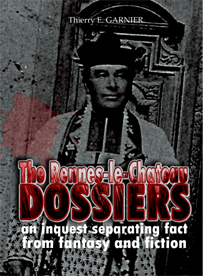 Despite the wave of recent disinformation contributed by some authors avid for sensationalism, the mystery of Rennes-le-Chateau remains still very much to be discovered in its totality. After nearly thirty years of assiduous work on the subject, Thierry E. Garnier, objective researcher and passionate author notably, publisher and editor-in-chief of the only and indispensable Encyclopedia on the subject, the now legendary L’ABC de RLC – harvests and consolidates the benefits of these thirty years’ research into this complex and still shimmering mystery, his multiple fields of knowledge, his competencies acquired on the terrain, in the south of France, as well as his encounters, interviews and contacts, to undertake an objective and illuminating inquest starting from ground zero.
Despite the wave of recent disinformation contributed by some authors avid for sensationalism, the mystery of Rennes-le-Chateau remains still very much to be discovered in its totality. After nearly thirty years of assiduous work on the subject, Thierry E. Garnier, objective researcher and passionate author notably, publisher and editor-in-chief of the only and indispensable Encyclopedia on the subject, the now legendary L’ABC de RLC – harvests and consolidates the benefits of these thirty years’ research into this complex and still shimmering mystery, his multiple fields of knowledge, his competencies acquired on the terrain, in the south of France, as well as his encounters, interviews and contacts, to undertake an objective and illuminating inquest starting from ground zero.
Did Abbe Sauniere, the famous priest of Rennes-le-Chateau, truly find a treasure? What was the origin of his wealth? Is his secret one concerning Christianity, and possibly capable of undermining the Vatican, and to what extent does it have anything to do with the Da Vinci Code? In it one has spoken about the ancient treasure brought from the sacking of the Temple in Jerusalem? A wisigothic Thietreasure or that of the templars?
Thierry E. Garnier, in this definitive book, unlike any other available to english-reading public and geared expressly to it, starting from the present walks backward on the path to the origin of this massive mystery and for the first time, speaks to us in detail about the reality of this enigmatic and somewhat suspect Priory of Sion…that one discerns in filigrane throughout this curious affair… This is not a question of one more book on the subject, but on the contrary of a book which puts in proper perspective the certitudes that we think we possess in this affair of Rennes-le-Chateau. The author leads us to an entirely new reconsideration of the problem in order to offer all the keys necessary to throw wide open the door of the ENIGMA…
Ancient & Primitive Rite of Memphis-Misraïm—Historic Notes – Jean Bricaud
Preface by Denis Labouré
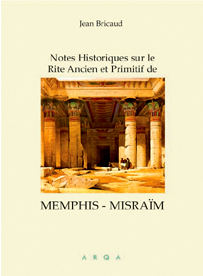 For Jean Bricaud : “The rite of Memphis-Misraïm can only be suitable for a very restricted number of individuals. They are recruited principally among the students of Occultism and Hermetism, who, by the fact of their studies, are more apt than others to understand true initiatic secrets; as well as among studious Masons, who are not content to know how to make certain signs or merely to learn the pronunciation of certain words, of whose meaning they are ignorant, but who want to go back to the real source of our institutions and to study the occult and transcendent part of Masonry ”.
For Jean Bricaud : “The rite of Memphis-Misraïm can only be suitable for a very restricted number of individuals. They are recruited principally among the students of Occultism and Hermetism, who, by the fact of their studies, are more apt than others to understand true initiatic secrets; as well as among studious Masons, who are not content to know how to make certain signs or merely to learn the pronunciation of certain words, of whose meaning they are ignorant, but who want to go back to the real source of our institutions and to study the occult and transcendent part of Masonry ”.
Denis Labouré, as an initiate steeped in the higher occult sciences of Alchemy, Astrology and Theurgy, proposes to us in a luminous preface of enlightenment pertinent to this short text dating from 1933 in its first edition and 1938 in its second. This opuscule,having become quite rare and conserved only in private libraries, fully merited a new presentation in order to give the true seeker an overview concerning this Rite, via certain authentic points of reference and some dates.
Table of Contents
Preface by Denis Labouré—Notice—Constant Chevillon—Origin of the Rite of Memphis-Misraïm—Jean Bricaud—Chronology of the Rite of Memphis-Misraïm—Jean Bricaud—Acknowledgments.
80 pages – ISBN 2755100222
(extract)
“We know that current mastery is only, in its sum, but a pale reflection of primitive initiation, the allegorical drama of which had become disfigured in what followed in terms of the political events of the period of its renewal. While the moral symbolism leaves there a greater share for the philosophic symbols, the alteration of the system is such and the developments of it are so incomplete that today it requires the skill of an instructed venerable to give interest to the interpretations of the diminished hieroglyphs (even the Phoenix has disappeared) of this beautiful grade. If, as we would desire, one wishes to double the three symbolic degrees, true grades of tests, commented and elaborated in the three schools of instruction what we have proposed with three corresponding grades, called philosophic or of the Greater Mysteries, in which will be developed the ancient secret doctrines, one will there open to the adept the deposit of this knowledge and of their most useful truths; he will recognize the truth of the alliance of the two systems, the symbolic and the philosophic in the allegories of the monuments of all ages, in the writings of the priests of all the nations and in the rituals of the mysterious societies; he will see a constant series, an invariable uniformity of principles, which share in an ensemble, vast, imposing and true, and which cannot really be well coordinated but there. The seductive charm of knowing and the ardent desire to know could motivate the adept to penetrate into the sanctuary while traveling the spiny pathways which lead there and, strengthened by a strong will, a constant perseverance and a study without prejudice, he will arrive at lifting the veil; and the secret of these allegories, of these emblems, of these symbols, of these sacred enigmas, will cease to be a mystery to him; for nature will be unveiled to him. In his third class Bricaud himself explains to us the preoccupations of the Primitive Rite of the Philadelphes. In the Ancient and Primitive Rite of Memphis, to which later came to be adjoined, the Rite of Misraïm, (…).”
Origin of the Rite of Memphis -Misraïm
The Masonic order is divided into different Rites, which, while diverse, are nevertheless all based on the three degrees of Masonic Symbolism.
In France, the Rites currently practiced are: The French Rite (Grand Orient), the Scottish Rite (Grand Lodge and Supreme Counsel), the English Rite (National Grand Lodge), the Scottish Rite Rectified (Lodges of the Scottish Masters of Saint-Andrew in the National Grand Lodge) and finally the Rite of Memphis-Misraïm (Sovereign Sanctuary).
Let us mention also the Mixed Rite, practiced by the Droit Humain and by the Grand Lodge Mixed, although outside of traditional Masonry because it initiates women with the same title as men, and is a schism of the Droit Humain.
Our goal is not examining the organization of these Rites, but gathering together in a few pages certain notes and historic dates concerning the Rite of Memphis-Misraïm, we will simply state that each of these Rites has its regulating authority and its hierarchy. The authority recognized by each Rite, has only the right to constitute Masons, by promulgating the decrees in this Rite and conferring the degrees of its hierarchy.
The Ancient and Primitive Rite of Memphis-Misraïm, respecting over all the traditional principles of Freemasonry that it has maintained and desires to maintain intact, would like to state that it respects the independence of other Rites and though it will not mingle itself in any way with the acts emanating from their authority, it understands that the other Rites act in this respect in the same manner. The rite of MM is the heir of masonic traditions from the 18th century, whose sage principles, moral force and discipline it has guarded. It draws its origin from the Occult Masonry of the Philalethes of Paris, from the Freres Architectes Africains of Bordeaux, from the Academy of True Masons of Montpellier, from the Pernety Rite of Avignon, and especially from the Primitive Rite of the Philadelphes of Narbonne. It is to the Primitive Rite of the Philadelphes, established around 1779 at Narbonnne by le Marquis de Chefdebien as the Ancient and Primitive Rite of Memphis-Misraïm traces back to it the origin of its principles and the form of its organization. The regime was divided into three classes of masons which received ten degrees of instruction. These classes or degrees were not thee designation of such or suc grades, but certain denominations of collection being able to be understood in an infinite number of grades. The third class, formed of four chapters of Rose-Croix is occupied with masonry from the esoteric point of view and in particular studies the occult sciences. The Primitive Rite of Narbonne was aggregated to the Grand Orient in 1806, but, in April 1815 at Narbonne, it the Rite underwent a sort of rebirth. In 1798, the primitive Rite of Narbonne had been imported into Egypt by certain officers of Bonaparte’s army, which had installed a Lodge in Cairo. It is in this lodge that Samuel Honis was initiated, who when he came back into France in 1814, reestablished at Montauban, in 1815, a Grand Lodge under the name of the Disciples of Memphis, with the assistance of Gabriel Marconis de Nègre, the Baron Dumas, the Marquis de la Roque, J. Petit and Hippolyte Labrunie, veteran brothers of the Rite. The Grand Master was the F. Marconis de Nègre. Following these intrigues, this Grand Lodge was put to sleep on March 7, 1816. The works were taken up again in 1862 by a part of its members under the obedience of the Grand Orient of France.
Some years later, several brothers, among them Etienne Marconis de Negre, son of the Grand Master of the Disciples of Memphis and high grade of the Rite of Misraïm, had the idea of uniting the degrees of the various Rites, practiced up until then and consolidated them under the principles adopted at Montauban. They examined the degrees of the various rites, revised them and squared them with a certain number of degrees reassembling and explaining the religious dogmas of the ancient Hierophants and of the ancient Initiations, then they will give this organization the title of the Ancient and Primitive Rite of Memphis. The degrees of initiation were divided into three series and seven classes which are much fewer rows of degrees than Schools, where as in the Primitive Rite of Narbonne, are taught the masonic sciences.
The first series teaches the moral part, resting on the knowledge itself. It offers the explanation of the symbols, emblems and allegories; it disposes the initiates to study masonic philosophy.
The second series comprises the study of the history of the most universally expanded masonic rites, as well as the poetic myths of antiquity and of the ancient initiations.
The third series contains the complement of the historic part of the philosophy, it studies the religious mythology of all the different ages, as well as all the branches of the science called “occult” or “secret”; finally, with regard to Masonry, it makes known the mystical and transcendent part, composed of esoterism and the greater mysteries, and admits the most advanced occult studies.
Not only is each of these three series formed of several divisions in which are conferred all the modern masonic degrees, but also, all lead progressively through the ancient mysteries wherein are revealed the reason for the existence of these degrees, the last series revealing esoterism of Masonry, the gnosis, this science which is perpetuated from century to century down to our time and illumines today our institution.
Such is the origin and constitution of the Ancient and Primitive Rite of Memphis, to which has later been adjoined the Rite of Misraïm.
According to what has just been said, one can easily understand that the rite of Memphis-Misraïm can only be suitable for a very restricted number of individuals. They are recruited principally among the students of Occultism and Hermetism, who, by the fact of their studies, are more apt than others to understand true initiatic secrets; as well as among studious Masons, who are not content to know how to make certain signs or merely to learn the pronunciation of certain words, of whose meaning they are ignorant, but who want to go back to the real source of our institutions and to study the occult and transcendent part of Masonry (…).
Jules Bois (1868 – 1943) – Reporter of Occultism, Poet and Feminist of La Belle Epoque – Dominique Dubois
 Dominique Dubois, like a veritable Arsene Lupin, succeeds in a tour de force in digging up for this work a great many unpublished documents concerning fin de siecle occultism. An authentic researcher, Dominique Dubois retraces knowingly the wings of the Belle Epoque, the duels of Jules Bois against Guaita and Papus are not forgotten, and neither are the secret and initiatic societies. Martinism, Freemasonry, the Theosophical Society, the Fraternity of the Star, Alan Kardec’s spiritualism, the Golden Dawn, the Gnostic Church, AMORC… And also, certainly, Emma Calve, Maurice Leblanc… the mysterious prowling shadow of Rennes-le-Chateau is not absent from this work perfumed with mysteries. With an index of more than 600 names, this book, a true goldmine for seekers, will remain as a definitive reference on this unknown, and here, finally rehabilitated, personage—Jules Bois—and as an inevitable documentation on this highly prolific period…. “Who comes to mind when one evokes the militant feminist, writer, poet and reporter on occultism, the journalist and diplomat? Only those impassioned by the Occult Sciences, rather a minority in this mad mad world, respond without a shadow of a doubt, “Jules Bois,” since life offered to him the privilege of occupying center stage of esoteric Paris, throughout the period of this fascinating universe of La Belle Epoque ”
Dominique Dubois, like a veritable Arsene Lupin, succeeds in a tour de force in digging up for this work a great many unpublished documents concerning fin de siecle occultism. An authentic researcher, Dominique Dubois retraces knowingly the wings of the Belle Epoque, the duels of Jules Bois against Guaita and Papus are not forgotten, and neither are the secret and initiatic societies. Martinism, Freemasonry, the Theosophical Society, the Fraternity of the Star, Alan Kardec’s spiritualism, the Golden Dawn, the Gnostic Church, AMORC… And also, certainly, Emma Calve, Maurice Leblanc… the mysterious prowling shadow of Rennes-le-Chateau is not absent from this work perfumed with mysteries. With an index of more than 600 names, this book, a true goldmine for seekers, will remain as a definitive reference on this unknown, and here, finally rehabilitated, personage—Jules Bois—and as an inevitable documentation on this highly prolific period…. “Who comes to mind when one evokes the militant feminist, writer, poet and reporter on occultism, the journalist and diplomat? Only those impassioned by the Occult Sciences, rather a minority in this mad mad world, respond without a shadow of a doubt, “Jules Bois,” since life offered to him the privilege of occupying center stage of esoteric Paris, throughout the period of this fascinating universe of La Belle Epoque ”
300 pages – ISBN 275510001X
(extract)
Jules Bois was, in our opinion, one of the greatest occultists of his era, this period that is called “belle,” and which, as regards the time, was so in appearance. That is to say, without a care and light-hearted, in full economic, artistic and social mutation. A time when the arts and letters had a revolutionary impact on all of life. In derision they were dubbed “the Decadents,” all these poets, painters, musicians poseurs, astrologers and magicians. Proud of their ideas, talented, discoverers of worlds, of colors and of chimeras, they drowned in symbolism and exceptional discourse. Woman was for them, the archetype of redemption of a humanity in quest for true knowing, for an original and occult consciousness buried in the memory of the Unconscious and of karmic rediscoveries, the only true quest there is, the quest for the Self, and through that, for solar initiation, to the very ends of the worlds. Proud and stormy, it was on the field that they regulated lapses of honor. Verbal or written attacks, iniquitous calumnies were found to be thus acquitted at a rather high price, in the tender grass of early morning in front of Amazons, numb in the cold, trembling at the first blood, before witnesses contrite at such behavior, often certain friends or family, who possessed affections for both sides. But the period, this Belle Epoque of duty and of a sense of honor that demanded, between Mars and Mercury, a particular attention to the realities of destiny. They were the cursed, the vain, the dark ones, the Nabis, the Rose-Croix of a period, where refinement was their intuition, symbolism their language, rebellion their art of living, la Boheme their standard, the green muse their elixir, Satan, sometimes, serving as their guide. From diverse horizons, from rural France as well as from Paris’s best areas, they ran, attracted as they all were by the lights of the city; certain aristocrats such as Henri de Régnier, Toulouse-Lautrec, Antoine de la Rochefoucauld, some bourgeois, certain gifted ones as well, like Baudelaire, Mallarmé or Gauguin. And all the others, those without status, the little people, avid for gold and seductive perfumes, coming out of God knows where in this sleeping France, ingesting from the soil, the lavenders, and the somnolent juice at the edge of the clearings certain patois, certain accents, which will serve as passports once having arrived in the capital. Jules Bois, whose predestined beginnings, dressed in black, believed with all his heart in his own star, he was among those who came conquering. Practical magic, magnetism, alchemy, revived then in Paris the purist currents of the Middle Ages. And the breath of the Temple, like a cloud over a sanctuary, was never very far from the nocturnal experimentations. In the shadow of the cathedral, behind the eyes of reddened coals, by the readings in candlelight, slept the great initiates of La Belle Epoque. “I have opened a door on the darkness, and from this darkness, mounts certain unexpected lights.” Maurice Leblanc in “Les Trois Yeux.” Jules Bois, astonishing personage, tormented in the extreme, activates his destiny in this beginning of a century like an infernal machine, to go back in time. The torment is for him an inebriating perfume, a profound and ecstatic joy. He was not of a period where one cauterized the wanderings of the soul, but where one sees them as a creative or destructive dynamic, and exists accordingly. An action imposed itself on him, to write without pause, to the very end of his breath, a mission thereby is accomplished–the reconnection with the sacred. He assiduously frequents his artist friends, during this balanced period, in the cafes, the salons, the artists’ studios. In the backrooms of specialized bookstores or lodges, he cultivated relations, he gets close to disciples, those like himself, his brothers. The subterranean networks, invisible to the profane activate, interpenetrate, become close with, fall out and are anathematized. Jules Bois, prolific writer (…).”
Set-Typhon, Spirit of Darkness – Hippolyte Boussac
Preface by David Fabre
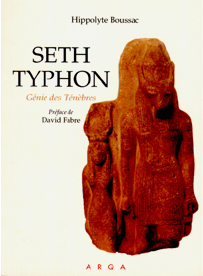 A book from 1907 republished by Editions Arqa—Followed from the same author by: “Reptiles represented on the Small Funerary Stelae of Horus.”
A book from 1907 republished by Editions Arqa—Followed from the same author by: “Reptiles represented on the Small Funerary Stelae of Horus.”
Who was Hippolyte Boussac (1846-1942), this erudite from the Langue d’Oc, impassioned by Egyptology, an exceptional designer, water-colorist, painter, naturalist, writer and friend of the celebrated Gaston Maspero?
Editions Arqa publishes, upon the occasion of the exposition “Hippolyte Boussac and Egypt” in the space Paul Riquet at Beziers from July 24-September 27, 2004, with a biographical foreword and a preface of presentation, permitting the restitution of the “God Set-Typhon,” the second concerning “Reptiles on the Small Funerary Stelae of Horus.” (These stelae were usually in serpentine or basalt, coming especially from the earlier periods.) A work largely illustrated by numerous drawings of the author.
(extract)
“Violently surging out of the womb of his mother, leaping” across the maternal flank, that he had torn open by striking it with a great blow, Set manifested, according to Plutarch, a violent and malefic character from his very entrance into the world. With same blow, he seeded disorder and confusion into the world. Set played an integrating part in the mindset of the Egyptians. Figure of the imagination, he contributed to describing and understanding the world. In pharaonic Egypt’s polytheism, the Egyptian Set is the representation of the other, the agitator for disorder, at the very heart of the divine world. Violent and ambivalent god, he is linked to foreign countries, to the desert and to marginal regions of the ordered world. His conflict with Osiris and Horus translates the constant struggle of the world into comprehensible form. He kills Osiris to take over the royal status that belongs to Horus; though aggressive and a fighter, he renders a service to the sun god in piercing the serpent Apophis. Set’s ambivalence appears in his fabulous animal, an indeterminate species, comprising fantastically the characteristics of one or several creatures and which is a way of describing the nature and function of the god. He is the “lord of confusion” of which the animal serves as a determinative for the “rage,” “storm,” “tempest,” etc., and his voice is the rolling thunder which dominates the most dangerous. Set, violent and impulsive, provokes and masters the storms and the outrageous. If his birth marks the “beginning of confusion,” Set is a part of the Ennead of Heliopolis. His combat against Horus expresses the duality of the world: Horus is the Lord of Lower Egypt and Set is the Lord of Upper Egypt. This bi-partition North—South is the reflection of an East-West bi-partition, that of the Nile Valley and of the foreign countries. The black earth spread by the flooding of the Nile, giving fertile soil over which the pharaoh has principal authority, is opposed to the red earth, the desert, vast and desolate country, inhabited by strangers and over which the pharaoh claims supremacy. Horus and Set participate in the pharaonic ideology: the king unites in his person the two gods in incessant struggle, which finds an equilibrium within him. If he is a dangerous god and an agent of death, Set is also the master of several great cities, one of the patrons of the monarchy and auxiliary of the sun in his struggle against Apophis: battle, constant confrontation, confusion and the questioning of the established order, actions in which Set engages, are the necessary characteristics of the existing world and of the limited disorder which is essential to a living order. The obsession of some to see in the Egyptian civilization a society resolutely oriented toward death and at the same time to see in Set the unforgivable murderer of Osiris, god of the dead, has given a deformed vision of the god. The proscription of the god, manifested in the later period, is sensible in all the funerary texts, practically from the origins. The image of a god absolutely held in contempt, proscribed by all and everywhere is false. It obliterates, in any case, more than two millenia of his history and misunderstands the signs of a positive role, necessary within it, discernible until the end of paganism. Some have seen in Set the troublemaker, the necessary evil, others a sort of Cain, first murderer, condemned to wander… But Set is this god, who is always situated (…).”
